Medicinal & Aromatic Plants
Open Access
ISSN: 2167-0412
ISSN: 2167-0412
Review Article - (2020)Volume 9, Issue 5
In the present scenario of COVID-19 strike and lack of potential antiviral medicines/vaccines against this extremely contagious lethal infection, identifying potential natural plant sources that can help in fighting this disease either by being viricidal or by boosting the immune system can provide significant therapeutic support. Around the globe as of 26th July 2020, there is ~15.78 million confirmed cases and 0.64 million deaths. The COVID-19 infection is produced by virulent Severe Acute Respiratory Syndrome-Coronavirus-2 (SARS-CoV-2) virus, which belongs to large corona virus family. These viruses are responsible for many recent infection outbreaks, SARS in 2003, MERS (Middle East Respiratory Syndrome) in 2012 and recent most fatal COVID-19. Also, mortality rate related to COVID-19 is found to be very high in case of people with weak immune system e.g. elderly patients, children or patients with preexisting health problems. In this relevance, medicinal plants can act as potential healing agents that can help people to fight against this infection by boosting their immune system or by posing viricidal effect. And thus, can contribute in reducing mortality rate related to SARS-CoV-2 infections. In this review, we attempted to compile and discuss different traditional medicinal plants and their bioactive components that help in strengthening our immune system and also play key role in combatting microbial infections including COVID-19. This article will help researchers and industries to identify and scrutinize potential medicinal plants that can meet their interests for various applications including development of herbal/Ayurvedic antiviral drugs, designing antimicrobial/antiviral materials, development of immunopotentiator, preparation of potential sanitizer systems etc.
Medicinal plants; Immunity booster; Antiviral; COVID-19; Traditional medicines
World is in great depression due to the massive spread of novel corona virus i.e., SARS-CoV-2, which has affected majority of the countries with more than 15.78 million confirmed cases and about 0.64 million deaths as of 26th July 2020 [1]. Moreover, persons with weak immune system are found to be the easy targets of this COVID-19 disease including old age persons, children and patients with pre-existing clinical history like diabetes, cancer, respiratory disorders etc. [2]. Considering high mortality associated with this disease, whole world is struggling hard to discover effective therapeutic solution for COVID-19 treatment either by developing new antiviral drugs or by repurposing the existing antiviral drugs. The commercially available antiviral medicines including ritonavir ribavirin, lopinavir, remidisavir alone or in combination with chloroquine, hydroxychloroquine, and interferon-alpha are found to show some potential against SARS-CoV-2 infections [3]. The most promising remedy for controlling this SAR-CoV-2 outbreak is the development of safe and effective vaccine against COVID-19 and enormous research efforts are in progress in this direction. According to WHO, nine vaccines had already entered the clinical trials as of 14th August 2020 [4]. In the present scenario of lack of any proven medicines/vaccines for COVID-19 cure, potential antiviral and immune booster herbal medicines, extracts and formulations can be good remedy which can help in lowering down the global mortality rate related to COVID-19. Ministry of Ayush, India has already released the self-care guidelines for preventive health measures and boosting immunity with special reference to respiratory health using traditional Ayurveda and natural herbs [5].
In the present review, we have discussed briefly about i) the novel SARS-CoV-2 virus including its structure and associated global human loss, ii) Potential herbs that have antiviral and immune stimulant properties that can help in fight against COVID-19, iii) Promising phytochemicals that can be used for the development of future medicine and vaccines against SARSCoV- 2 infections, and finally iv) summarize active antimicrobial biochemical that can be useful in controlling COVID-19 spread by being an active components of sanitizers, personal protective equipments (PPE’s) and antimicrobial materials/surfaces. Thus, we are here in discussing about various medicinally important plants and herbs which can serve as boon in the fight against COVID-19 e.g. Garlic (Allium sativum), Margosa neem (Azadirachta indica), Tulsi (Ocimum sanctum), Giloy (Tinospora Cordifolia), clove (Syzygium aromaticum), ginseng (Panax quinquefolius L.), Betel vine (Piper betel), Black paper (Piper nigrum), Black cumin (Black cumin L.), Ashwagandha (Withania somnifera), Licorice astragalus (Astragalus glycyphyllos), turmeric (Curcuma domestica), elderberry (Sambucus nigra), Giloy (Tinospora Cordifolia) etc. These plants are known to be rich in antioxidants, vitamins, proteins, carbohydrates, dietary fibers, amino acids, minerals, steroids, alkaloids, antiviral, antibacterial phytochemicals which will help in rejuvenating the immune system and also helps in killing the invaded viruses. Figure 1 shows pictures of different herbs that may be helpful in prevention and treatment of COVID-19.
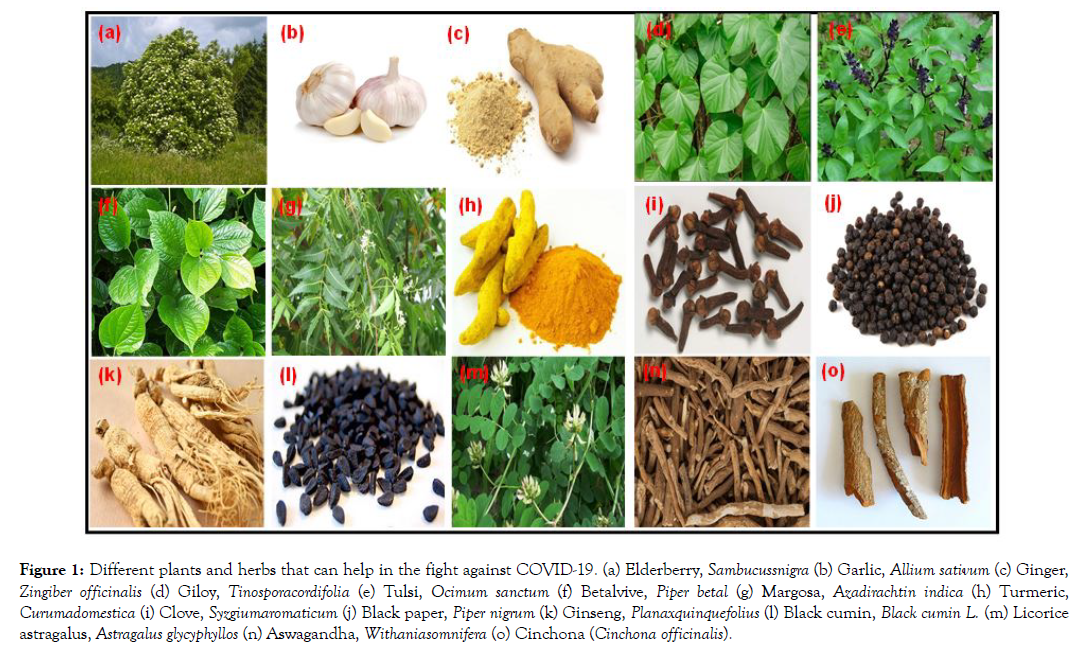
Figure 1: Different plants and herbs that can help in the fight against COVID-19. (a) Elderberry, Sambucussnigra (b) Garlic, Allium sativum (c) Ginger, Zingiber officinalis (d) Giloy, Tinosporacordifolia (e) Tulsi, Ocimum sanctum (f) Betalvive, Piper betal (g) Margosa, Azadirachtin indica (h) Turmeric, Curumadomestica (i) Clove, Syzgiumaromaticum (j) Black paper, Piper nigrum (k) Ginseng, Planaxquinquefolius (l) Black cumin, Black cumin L. (m) Licorice astragalus, Astragalus glycyphyllos (n) Aswagandha, Withaniasomnifera (o) Cinchona (Cinchona officinalis).
SARS-corona virus-2 and COVID-19
Corona viruses are spherical enveloped positive sense RNA viruses from Coronaviridae family and order Nidovirales. This virus is broadly distributed among different mammalian species including humans. Although most of the corona virus infections are associated with mild clinical symptoms in human, however, two beta coronaviruses are responsible for two serious epidemics; severe acute respiratory syndrome corona virus (SARS-CoV) emerged in November 2002 in Guangdong, China and middle east respiratory syndrome corona virus (MERS-CoV) originated in 2012 in Saudi Arabia [6]. During last two decades, both the viral infections are reported to result in >10,000 cumulative cases with high death rates i.e., 10% for SARS-CoV and 37% for MERS-CoV [7]. In December 2019, a series of serious pneumonia cases appeared due to mysterious source of infection in Wuhan [8]. Upon genetic sequence analysis, it was realized that this serious and contagious infection is due to a novel corona virus species, originated from bat, which was later named as 2019 novel corona virus (2019-nCoV) [4]. Being seventh member of the corona virus family, this virus is also called as SARS-CoV-2 due to its >70% resemblance to SARSCoV in genetic makeup [9]. COVID-19, infectious disease caused by SARS-CoV-2 virus, is a serious infection of the respiratory tract which affects both the upper respiratory tract including throat, nose and sinuses and lower respiratory tract, i.e., windpipe and lungs, of a person. As of 18th May 2020, there are more than 4.7 million confirmed cases of COVID-19 with more than 315,000 confirmed deaths across the world affecting 213 countries and territories.
On the basis of structural studies, CoVs are the large genome size RNA viruses with sizes in the range of 26 to 32 kilo bases in length. Genome of CoVs encodes for four key structural proteins viz. i) spike (S) glycoprotein, iii) nucleocapsid (N) phosphoprotein, ii) membrane (M) glycoprotein, and iv) envelope (E) glycoprotein (Figure 2). In SARS-CoV-2 virus, hemagglutinin-esterase (HE) protein is also found in the virus envelope. All these proteins are vital for the development of complete virion structure [10,11]. The S glycoprotein, which forms a homotrimer protruding from the virus surface, mediates the entry of the virus into the host cells [12]. S protein has two functional subunits where S1 subunit is associated with the binding of the virus with the host cell angiotensin-converting enzyme 2 (ACE2) receptors and S2 subunit assists the fusion of the virus with the cellular membrane [11]. Different corona virus species have unique domains at its S1 subunit to recognize different host cells entry receptors. The SARS-CoV-2 S1 subunit engages with human ACE2 with similar affinity to SARS-CoV. Strong binding to ACE2 to the host cell someway explains the fast-human transmission of SARS-CoV-2, same as SARS-CoV. SARS-CoV-2 virus is found to be transmitted from human to human via small respiratory droplets through coughing, sneezing, or while executing close proximity interactions among people [13]. These droplets can then transmit by inhalation or can contaminates different surfaces which will act as secondary source of infection when the other person touch these surfaces and then touch their eyes, nose or mouth. Given the high mortality rate associated with COVID-19 and its easy mode of transmission, WHO declared SARS-CoV-2 pandemic a public health emergency of global concern on 30th January 2020 [1].
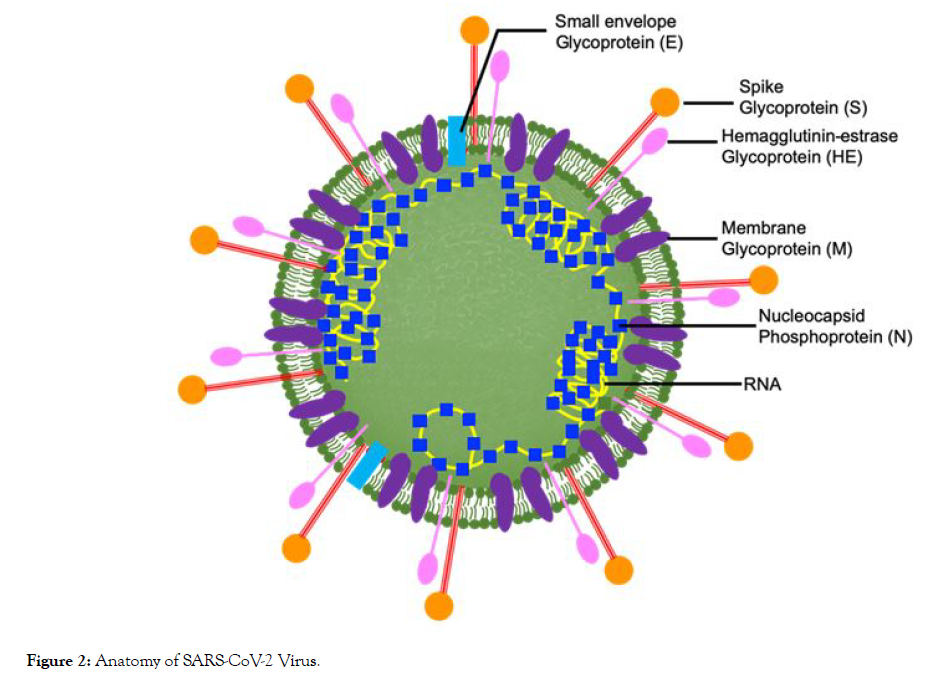
Figure 2: Anatomy of SARS-CoV-2 Virus.
Medicinal plants that can help in fight against COVID-19
Piper nigrum L. (Black Pepper, Kaali Mirch): Piper nigrum L. is also referred as king of spices due to the extensive use of its dried unripe fruit in almost all cooking worldwide [14]. Moreover, this plant is enriched with more than 600 different phytochemicals including lignans, alkaloids/amides, terpenes, neolignans etc. having different beneficial biological activities and medicinal properties. Antiviral, anti-bacterial, antiinflammatory, anti-pyretic, anti-oxidative, anti-thyroid, antitumor, immune and vaccine bioavailability enhancing properties are among the few in huge list of beneficial biological functions of peppercorn and various secondary metabolites of Piper nigrum. Ahmed et al. have very extensively and nicely reviewed the biological role of black pepper [15]. With proven antiviral properties, particularly against viruses responsible for infection in the respiratory tract, its key alkaloid components piperine and 10 piperamides can be the potential phytochemicals that can help in the fight against COVID-19 which is also a respiratory tract infection [16]. The structures of these antiviral phytochemicals sourced from Piper nigrum are given in Figure 3. Different parts of Piper guineese, which is also known as West Black Pepper, have importance in internal medicine for treating gastric ulcers, rheumatism, bronchitis and also viral infections.
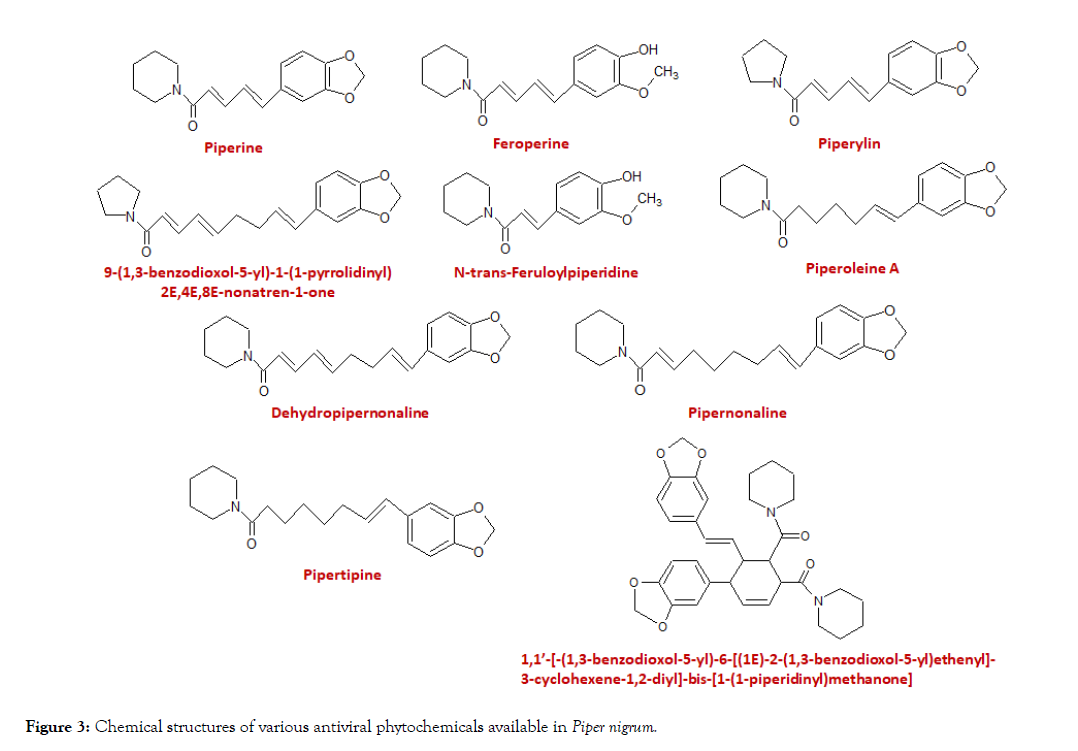
Figure 3: Chemical structures of various antiviral phytochemicals available in Piper nigrum.
Ocimum sanctum (Holy Basil, Tulsi): Tulsi, also called as holy basil, is an indigenous plant to India and is highly renowned for its medicinal properties in Ayurvedic and Siddha medicinal system. Many in-vitro and in-vivo reports on animals and humans have proven its therapeutic potential as antibacterial, antidiabetic, anti-carcinogenic, anti-viral, anti-inflammatory, cardio-protective, immune system booster etc. [17]. In Ayurveda, Tulsi is denoted as “Elixir of life” for its healing capability and promising potential in curing different health ailments including bronchitis, pyrexia, rheumatism, asthma, skin diseases, parasitic and microbial infections, gastric and hepatic disorders etc. Regarding the role of Ocimum sanctum in controlling COVID-19, Tulsi is already being used for curing pain, diarrhoea, cough and fever, which are common symptoms related to COVID-19 [18]. Tulsi is described as best medicine to treat pneumonia. Strong scientific evidences are available revealing the antiviral properties of Tulsi against both DNA viruses [herpes viruses (HSV), hepatitis virus, adenoviruses (ADV)] and RNA viruses (enterovirus 71, coxsackievirus CVB1) [19]. Apigenin and Ursolic acid are found to be the main active antiviral ingredients in the Tulsi extract. Tulsi is reported to improve the respiratory parameters and helps in recovering from asthma. Tulsi has significant importance and role in boosting the immune system that assist human body to fight against unwanted microbial strangers including bacteria and viruses. To assess the immunomodulatory effect of Tulsi leaves, a double blinded randomized study was performed where 300 mg of ethanolic extract of Tulsi was given to 24 healthy subjects and results were analyzed [20]. In this 4-week study, significant enhancement in the percentage of helper T-cells and Natural Killer (NK) cells was observed in the subjects, both of which are immune cells that help the body to fight against bacterial and viral infections. This corroborates the role of Tulsi as immunomodulatory agent. Because of its multimodal therapeutic properties, we hypothesize that Tulsi may help in the prevention and controlling of COVID-19. An interesting docking study abstract reported at Social Science Research Network (SSRN, Elsevier) studied the binding affinity of 7 photophilic compounds from Tulsii. i.e., tulsinol A, B, C, D, E, F, G, and dihydrodieuginol B, with SARS CoV receptors [21]. This simulation study further confirms the use of Tulsi extract against our fight against COVID-19 due to its recognized role in inhibiting replication of SAR-CoV with ACE II blocking properties.
Nigella sativa (Black Cumin, Black seed, Kalonji): Nigella sativa is known for its broad therapeutic value and is reported to cure different health disorders including jaundice, conjunctivitis, rheumatism, diabetes, anorexia, gastrointestinal problems, intrinsic haemorrhage, asthma, cough, bronchitis, fever, bronchitis, influenza etc. [22]. Thymoquinone is the main active phytochemicals present in black cumin and responsible for most of its therapeutic properties. Regarding its implication as antiviral properties, Nigella sativa oil and seeds have showed viricidal properties against various deadly viruses including hepatitis C virus (HCV) and HIV [23]. In murine cytomegalovirus mice model, N. sativa seed oil is found to suppress the viral burden to undetectable level within 10 days of intraperitoneal (i.p.) injection of black seed oil [24]. This is corroborated with the enhanced number of CD4+ T-cells and macrophages in serum and increased production of interferon- γ. In a case report, a complete seroreversion and regaining of 46-year old HIV infected patient was confirmed after treating her with 10ml twice a day daily dosage for 6 months [25]. In another case report, a young 27 years old HIV infected women was diagnosed during ante-natal care [26]. Due to its ineligibility to take antiretroviral therapy, she was kept at herbal therapy and given with 10 mL black cumin and honey mixture thrice a day for a year. Repeat serological testing for HIV infection confirmed the effectiveness of this herbal therapy in eradicating this serious HIV infection within 1-year time. In another group study of HCV infected patient, who are not eligible for IFN-α/ ribavirin therapy showed significant decrease in the viral burden (~50% showed considerable reduction and ~17% became seronegative) by practicing black cumin seed oil based herbal therapy [27].
Astragalus membranaceus (Astragalus): Astragalus roots have been used in various Indian and Chinese ayurvedic medicines which are very helpful in strengthening the immune system and fight against diseases. This herb is also popular as natural supplement that assist in combating stress, killing tumor cells and remedying the chemotherapy symptoms. Polysaccharides, containing mannose, D-glucose, xylose and Larbinose, available in the Astragalus are found to have anti-inflammatory, anti-microbial and antiviral properties [28,29]. In an in-vitro/in-vivo study published in 2013 on H9N2 avian influenza virus infected chickens, Astragalus polysaccharides is reported to enhance the immunity and prohibit the viral infection [30]. In the first week post treatment, IL-12, LITAF, IL-10, IL-6, IL-4 and antibody titers to H9N2 AIV is reported to be increased during in-vivo lymphocyte and in-vivo antibody titer analysis.
Cinchona officinalis (Cinchona, Quinine): Genus Cinchona covers around 40 species of trees. The Cinchona bark is rich in an alkaloid chemical called as quinine which is known for its excellent antimalarial properties. Its other biological and clinical roles include ant parasitic, anti-arrhythmic, anti-spasmodic, antiprotozoal, cardio tonic (tones, balances, strengthens the heart) and as a bitter digestive aid to stimulate digestive juices. Chloroquine, which is a synthetic form of quinine sourced from cinchona bark, is in use for centuries for malaria treatment. Chloroquine was a key component of mass drug administration campaigns to exterminate malaria during 20th century, and is also in the list of WHO essential medicines [31]. Antiviral properties of chloroquine are explored against HIV [32] and then against SARS-CoV-1 [33], which has structural similarity to novel SARS-CoV-2. In 2004, a Belgium researcher reported that chloroquine prohibited SARS cells replication in cell culture model [34]. In 2006, group of researchers from Chinese University of Hong Kong and Utah State University have investigated the effectiveness of multiple compounds against SARS-CoV in mice infection model [35]. They revealed that the chloroquine is only effective as an anti-inflammatory agent [35]. However, they suggested using chloroquine in amalgamation with other drugs to inhibit virus replication. Following this, in 2009, a Belgian based research group again revealed the effectiveness of chloroquine to eradicate lethal viral infection caused by human corona virus OC43, which is closely related to SARS, by administering this drug via mother ’ s milk [36]. Chloroquine plays role in raising the pH of the host cell lysosomes and thus interferes with the virus strategy to acidify the lysosome, which is a requirement for the creation of auto phagosomes where a cell approaches to eat themselves. Regarding the effectiveness of chloroquine against SARS-CoV-2, a recent study involving hundred COVID-19 affected subjects, chloroquine treated group is found to be superior in shortening the disease course, improving lung imaging findings, pneumonia exacerbation and increasing virus negative seroconversion with no side effects compared to control group [37]. In this first human trial against COVID-19, 500 mg dosage of the drug was given two times daily. In an expert consensus published on 20th Feb 2020 from multicenter collaboration group of Department of Science and Technology and Health Commission of Guangdong province, chloroquine phosphate tablets were suggested with dosage of 500 mg twice a day for 10 days for patients diagnosed with mild, moderate and severe cases of pneumonia related to SARS-CoV-2 [38]. Treatment using chloroquine may enhance the treatment success rate, shorten the hospital stay and lowers the mortality associated with COVID-19.
Sambucus nigra (Elderberry): Elderberry, scientific name Sambucus nigra, is an intense purple berry and widely present in Europe and Western Asia. It has been in use for many years due to its enormous health benefits. Chemically it is rich in polyphenolic compound (Anthocyanins, Flavonols, Phenolic acid), terpenes, carbohydrate (mainly glucose and fructose), citric acid, malic acid and lectins and other essential nutrients [39]. One cup of elderberries contains 106 calories [40]. However, their nutrient values in per 100 grams are as ~870 mg Vitamin A, 34.10 mg Vitamin C, 391.33 mg Potassium, 28.06 mg Calcium, 1.86 mg Iron, 217 mg Sodium [41] as well as some amount of other minerals, folic acid, amino acids, dietary fibers are also present. This fruit is enriched with flavonoids having antioxidant and anti-inflammatory properties that help protecting the healthy cells from the attack of harmful free radicals thus have implications in skin care, boosting immune system which will supports the body to fight against flu, cold and other respiratory infections. It is also reported to have antiinfluenza activity [42], as well as antitumor potential, reduction of uric acid, positive effect on blood pressure [39]. The berries can also be made into jam, pies and sauces. The unripen elderberries, its leaves, bark and seeds contains toxic and poisonous chemicals including cyanogening glycosides which may lead to vomiting, nausea and diarrhoea if taken in raw state [41]. However, appropriate cooking and consuming in the form of hot syrups helps in overcoming these side effects. The flowers and fruit of the elderberry can be consumed as jam, herbal tea, syrups, juices and is an effective remedy for colds and fever.
Tinospora cordifolia (Giloy, Guduchi): Giloy or Guduchi, scientific name Tinospora cordifolia is one amongst the most flexible restoring bushes. This is normal herb utilized as a part of Ayurvedic medication. It is one of the best Rasayana considered and is surprising in its strong flexibility. It holds many biologically important phytochemicals including lactones, alkaloids, glycosides, steroids, sesquiterpenoid, diterpenoid, aliphatic compounds, phenolics, polysaccharides and flavonoid which play immunomodulatory activity in human body [43]. It has anti-diabetic [44], antioxidant, Anti-inflammatory [45], antiperiodic, antispasmodic, anti-arthritic, anti-allergic [46], antimicrobial, anti-osteoporotic [47], antitoxic, anti-stress, anticancer, anti-HIV, wound healing [48], cardio tonic, carminative, bitter tonic, blood purifier properties which improve digestion and boost the immune system and also helps to reduce stress and anxiety, detoxification of body, to control fever, treatment in type-2 diabetes, fight against respiratory issue, improve eye vision, treat asthma and arthritis disease and helps in the tumor chemotherapy. In one of the studies, methanol extract of Giloy is found to have broad spectrum antimicrobial effectiveness against various strains which are Staphylococcus aureus, Klebsiella pneumonia, Escherichia coli, Shigella flexneri, Salmonella paratyphi, Salmonella typhimurium, Salmonella typhi, Enterobacter aerogene, Pseudomonas aeruginosa, Serratia marcesenses and Proteus vulgaris [47]. Due to its alkaloid components including tinosporin, tetrahydropalmatine, choline, palmatine and magnoflorine, it also has protective role against aflatoxininduced nephrotoxicity. With their broad beneficial activity, it plays important role to improve our immune system to fight against infectious diseases. Generally, extract (juice) of Giloycan be taken orally. The following herbal formulation is receiving enormous popularity and found to be helpful for preventing and curing COVID-19 disorder.
Giloy (Size on one Bhibdi) + Tulsi (6 leaves) + Ginger (1/2 tsp.) + Kali mirch (4-6 seeds)
Crush/Grind them all together and use it as herbal tea or mix it with honey and consume it. It can control cough, fever and also support immunity.
Azadirachta indica (Margosa, Neem): Margosa neem, scientific name Azadirachta indica almost found everywhere in India. Almost every part of neem such as leaves, root, fruit, bark, oil and seed are useful and it is widely applicable to cure or control diseases arises from parasitic, bacterial, viral or any other causes. The key phytochemicals available in neem are limonoids and terpene [49]. It has anti-inflammatory, antimalarial, antibacterial, antifungal, immunomodulatory [50], wound healing effect, hepatoprotective effect, antidiabetic activity, antinephrotoxicity effect, neuroprotective effects, anti-cancerous properties [51] and neem tree effectively works in air purifying. Due to their excellent properties, it is effective against around 200 microorganisms. Previously our ancestors are aware of their antibacterial and antifungal type activities described in Indian Ayurveda and Unani medication. The chemical constituents of neem nimbidin, sodium nimbidate, gallic acid, catechin, polysachharides are responsible for their anti-inflammatory activity while nimbidin, gedunin, cyclic trisulfide for their antifungal activity and nimbidin, nimbolide, mahmoodin, margolone, margolonone, isomargolonone for antibacterial activity [49]. Bioactive compounds isolated from neem seed oil possess antipyretic, antifungal and antimalarial activities. However, Azadirachtin from neem oil have strong insecticidal, antifeedant activity as well as antimalarial property to inhibit the development of malarial parasites. It also has antibacterial activity some pathogenic bacterial strains. For the treatment of dermal problems including scabies, eczema and ringworm, the extract of dry neem leaf is found to be very effective. Aqueous neem leaf extract is reported to have remarkable antiviral activity against measles virus, Chikungunya and Vaccinia virus [52,53]. Previously, many people utilized the neem extract (from leaves) for bathing to prevent against infection of chicken pox (causes due to varicella-zoster virus). Small amount of leave has also taken orally to kill the harmful worms inside body. It also helps in regulating blood sugar level in body. Although neem extract has many beneficial properties to benefit humans, however, taking excess amount of neem leave may have adverse effect on sexual activity by reducing of sperm count in body which may causes infertility.
Syzygium aromaticum (Clove, Laung): Clove, scientific name Syzygium aromaticum, is one of the precious spices which is in use as food preservative and for many therapeutic applications from ages. This plant is rich in carbohydrates, protein, vitamins (A, C, E and K), thiamin, riboflavin, folate, niacin, dietary fibers, and minerals. It is also rich sources of phenolic constituents like eugenol, thymol, eugenol acetate, and gallic acid and also β- cariophyllene and have enormous potential for cosmetic, pharmaceutical, food and agricultural applications [54,55]. It has analgesic, antioxidant, antitumor, antiviral, antifungal, antiinflammatory and antibacterial activity. Presence of augenol compound displayed antibacterial activity against Porphyromonas gingivalis and also prevent the biofilm formation activity of P. gingivalis. However, the clove originated eugeniin phytochemical is revealed to have good antiviral activity against herpes virus strains with effective antiviral dosage of 5 μg/mL [56]. Eugeniin reveals antiviral properties by inhibiting the virus DNA polymerase enzyme and subsequently prohibiting the DNA synthesis. However, the aroma chemicals isolated from clove were responsible for their antioxidant properties [57] This synergic activity of clove was stronger in the brain than in the skin and it was also proved that those combinations were not toxic to mice [58]. It is also reported the inhibition of Dengue Virus Protease by Eugeniin, Isobiflorin, and Biflorin isolated from the Flower Buds of Cloves [59].
Panax quinquefolius L. (Ginseng): Ginseng is mostly found in America and Asia and is very popular for its many beneficial medicinal products from years. It has antimicrobial [60] antioxidative, antidiabetic, anti-inflammatory, anticardiovascular disease and anticancer properties. It helps in enhancing the immunity, combating various cardiovascular diseases, neurological disorders and diabetes [61]. The major chemical compositions of ginseng are triterpenoid, protopanaxadiols, protopanaxatriols and steroidal saponins also known as ginsenoid, polysaccharides and proteins which are responsible for their potential activities against antibacterial or like other activity especially for pathogens that cause respiratory infections in human body. Moreover, the antimicrobial potential of ginseng and their bioactive components was also reported against various bacteria (Helicobacter pylori, Escherichia coli, Propionibacterium acnes, Pseudomonas aeruginosa, and Staphylococcus aureus), fungi (Fusarium oxysporum) and yeast (Candida albicans) species [60]. It is also found to be effective against different human viral infections such as rhinovirus, human immunodeficiency virus, influenza virus, hepatitis virus, norovirus, enterovirus, human herpes virus, rotavirus, and coxsackievirus respiratory syncytial virus [62]. In addition, ginseng inhibits the microbial motility and effects on biofilm formation and prevents the formation of mature biofilms [63]. It was reported for their potential benefit in treatment of health problem by boosting immune system to enhancement of cognitive function in central nervous system. As per the report, consumption of 150-300 mL of ginseng enriched milk can provide 11.5-23 mg of ginsenosides that helps boosting body immunity [64].
It also helps to fight against cancer, reducing blood sugar level, treatment of erectile dysfunction, and preventing the flu type problems. It has viricidal properties against respiratory syncytial virus which infects the lungs and breathing passages [65]. Ginseng stem‐leaf saponins are also found to be active in increasing the specific-antibody responses for infectious bronchitis virus and Newcastle disease virus [66]. The antiviral activity of ginseng is due to its efficiency to block viral attachment, membrane penetration and inhabiting virus replication inside the host cell. Use of ginseng appears to be also important for the development of novel therapeutics or to increase the effectiveness of the current treatment strategies for male reproductive diseases [67]. Similarly, it is reported ginsengarsenite interactions hindering the proliferation of MCF-7 breast cancer cells which further confirms the effectiveness of ginseng for cancer treatment [68]. Figure 4, shown the various viruses and bacteria’s which are targeted by Ginseng, along with the summary of ginseng-derived pharmacological activities.
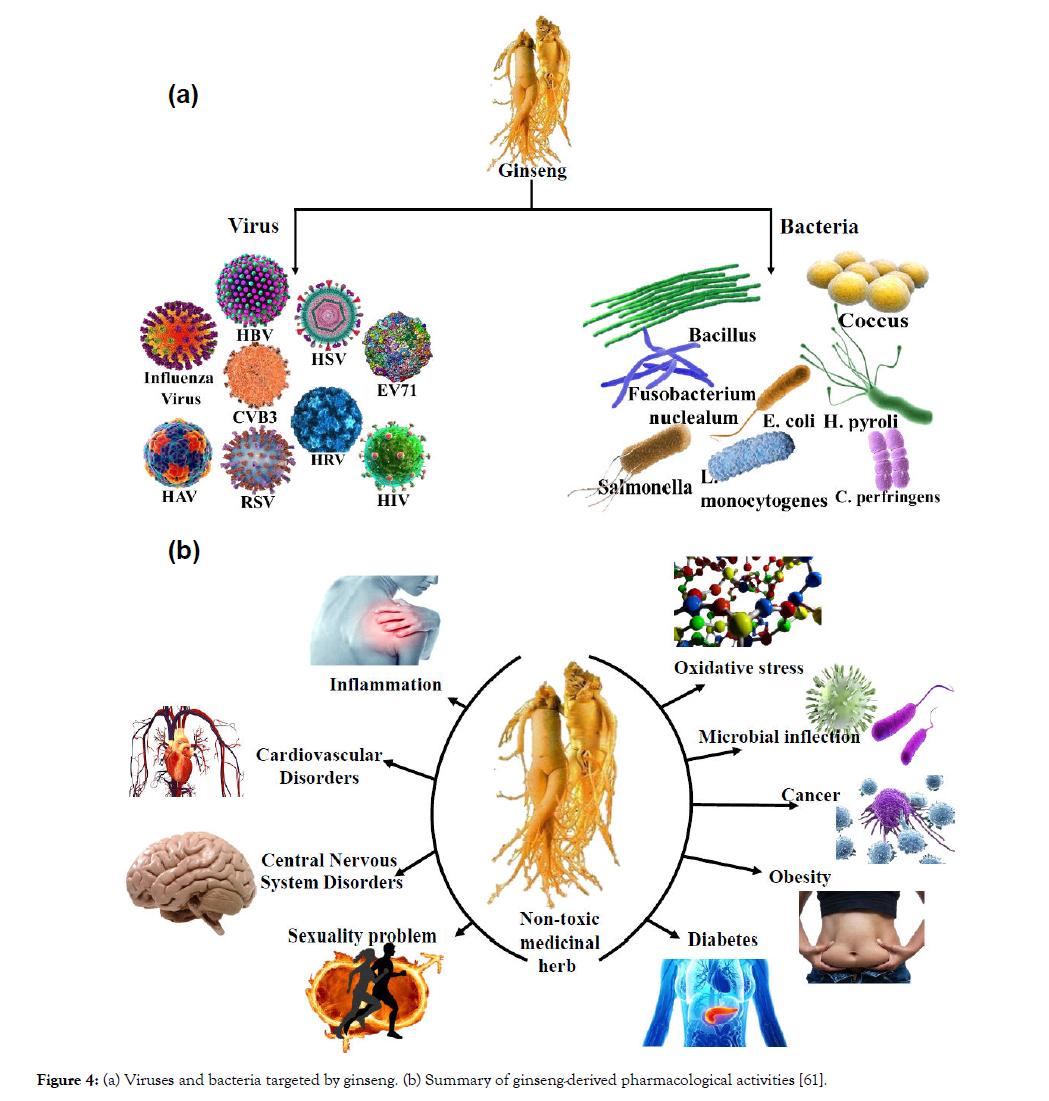
Figure 4: (a) Viruses and bacteria targeted by ginseng. (b) Summary of ginseng-derived pharmacological activities [61].
Glycyrrhiza glabra (Liquorice, Licorice): Liquorice or licoricean, herbaceous perennial plant belongs to bean family Fabaceae, and is the common name of Glycyrrhiza glabra. It is effectively used as antifungal, antibacterial, antiviral, anti-inflammatory, anti-diabetic, skin whitening, antioxidant anti-ulcer, anti-tussive as well as an anti-diuretic agent. The main constituent of liquorice root is lycyrrhizin which is sweetened in taste. It is also known as glycyrrhizic acid or glycyrrhizinic acid, with chemical formulae C42H62O16 and the structural formulae as shown in the Figure 5 below.
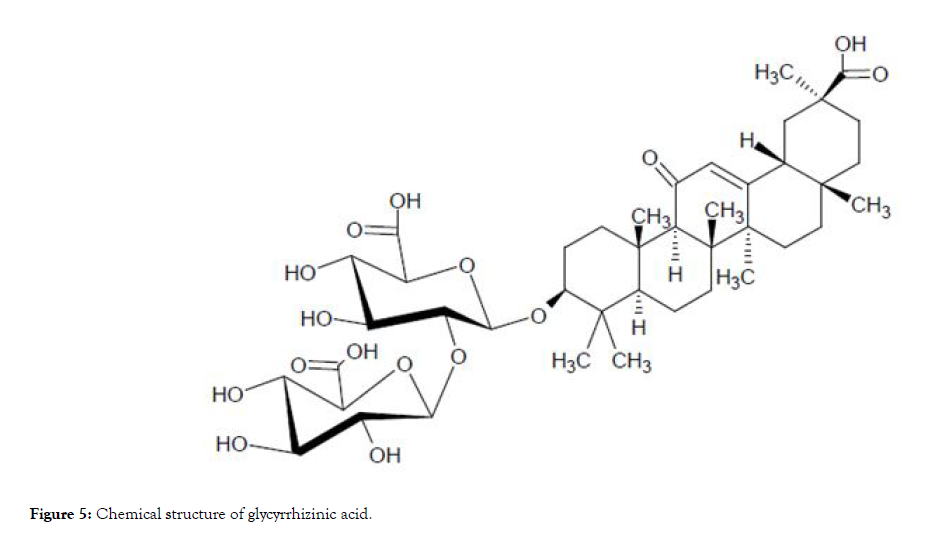
Figure 5: Chemical structure of glycyrrhizinic acid.
The phytoestrogens namely isoflavaneglabridin, isoflaveneglabrene and chalcones are also present in the roots of liquorice. The glabridin restrict the activity of cyclooxygenase and has an anti-platelet and anti-inflammatory characteristic. The root of this plant has medicinal values and been utilized for curing various problems related to asthma cough, colds and Chronic obstructive pulmonary disease etc. The pharmacologic perspective of glycyrrhizin-a triterpene saponine, which can be a potential phytochemical against COVID-19 [69]. The study reports about the binding of angiotensin and converting enzyme II (ACE2), also down-regulating pro-inflammatory cytokines and also blocking the inhibition of accumulation of intracellular ROS, thrombin, hyperproduction of airway exudates and inducing endogenous interferon. The authors have investigated Glycyrrhiza glabra (Liquorice); it is a potent medicinal herb in the form of its traditional uses, bioactive constituents and pharmacologic activities [70] and have studied the therapeutic effects of glycyrrhizic acid [71]. Similarly, authors have reported the clinical trial of few active compounds like pyrazofurin, 6- azauridine, mycophenolic acid, ribavirin, and glycyrrhizin against two corona virus clinical isolates FFM-1 and FFM-2 to evaluate their antiviral capabilities [71]. Among all the tested compounds, glycyrrhizin was found to be most effective in hampering the replication of the virus. Further, Fiore et al. also studied the antiviral effects of glycyrrhiza species. A randomized trial study in hepatitis B and C patients showed that the Glycyrrhiza glabra derived compound help in reducing the hepatocellular damage process [72]. The authors have investigated the antiviral properties of glycyrrhizic acid derivatives against SARS-CoV virus. They have tested 15 Glycyrrhizin derivatives for their antiviral activity against SARSCoV and reported that amides and conjugates of GL with two amino acid residues and 30 free -COOH functional groups depicted up to 70-fold increased activity against SARS-CoV. It was also reported that cytotoxicity characteristics being reciprocal to the selectivity index feature [73,74] It is also reported a review about the scope and antiviral activity of various bioactive molecules of present in of Glycyrrhiza glabra (Yashtimadhu) [75].
Andrographis paniculatais (Kalmegh): Andrographis paniculatais or Kalmegh, known as “king of bitters,” is an herbaceous plant belongs to the family Acanthaceae. Many phytochemicals which can be extracted especially from the stem and leaves of this plant includes flavonoids, diterpenes, andrographolide, noriridoides, xanthones and other miscellaneous compounds. The obtained extracts and pure compounds have antimicrobial, antiprotozoan, antiangiogenic, antidiabetic, anti-inflammatory, antioxidant, immune stimulant, hepato-renal protective, liver enzymes modulation characteristics. Due to which, it is mainly used for the traditional treatment of many severe diseases such as leprosy, bronchitis, flatulence, cancer, blood pressure, ulcer, diabetes, influenza, dysentery, colic, dyspepsia and malaria. The compound Andrographolide and its derivatives can be obtained from Andrographis paniculata and has chemical name 3-[2- [Decahydro-6-hydroxy-5-(hydroxymethyl)-5,8a-dimethyl-2- methylene-1-napthalenyl] ethylidene] dihydro-4-hydroxy-2(3H)- furanone and the structure is shown in Figure 6 below.
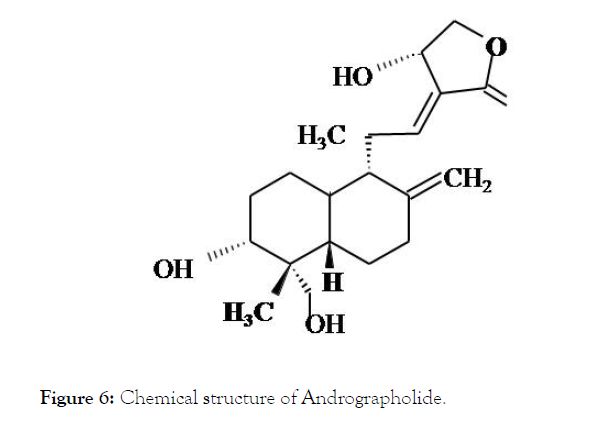
Figure 6: Chemical structure of Andrographolide.
The interesting literature review on the phytochemistry, ethnobotany and pharmacology aspects of Andrographis paniculata [76] and recently investigated the inhibitory role of Androgra pholideas against SARS-CoV-2 proteases using an in silico methodology [77]. They have focused on the valuable importance of compound Andrographolide which has been extracted from A. paniculate for the possible treatment COVID-19. Computational studies revealed that this molecule have good pharmacodynamics property, high solubility and target accuracy. Jayakumar et al. further reported a comprehensive review article related to clinical pharmacology of Andrographis paniculata and its major biologically active phytochemical andrographolide [77]. The authors investigated on connecting the medicinal properties of A. paniculata for diseases and beyond. The work is mainly focused on the past and present state of research on Andrographis paniculata with respect to the medicinal usage, pharmacological activities, toxicity profile phytochemistry, and therapeutic usage [78] and a detailed review and meta-analysis of A. paniculata for symptomatic relief of acute respiratory tract infections especially in adults and children [79].
Allium sativum (Garlic, Lahsun): Lahsun is one of the most important and common of all plants which are marked in the history of mankind. The chemical constituents of garlic majorly consist of sulphur based compounds which are responsible for its peculiar smell and taste which includes diallyl polysulfides, vinyldithiin, ajoene, S-allyl cysteine, alliin and few non-sulphur compounds like enzymes, saponins, maillard reaction products and flavonoids. The chemical structures of various phytochemicals present in Allium sativum are shown in Figure 7.
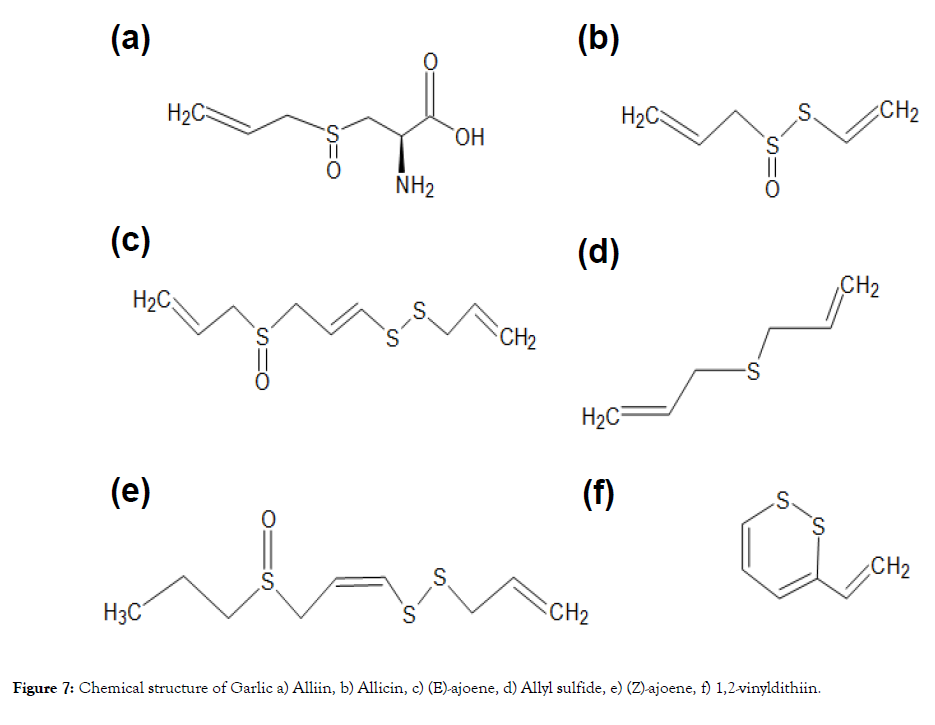
Figure 7: Chemical structure of Garlic a) Alliin, b) Allicin, c) (E)-ajoene, d) Allyl sulfide, e) (Z)-ajoene, f) 1,2-vinyldithiin.
Further, it has been reported by many researchers that garlic extract has various remarkable medical effects and powerful antiinflammatory and antiviral properties which helps on curing various types of diseases like cardiovascular, cancer, common cold, influenza virus [80,81]. Among other viruses, the Influenza virus is the most dangerous which is globally responsible for depression and distinctness along with several antigenic drifts and shifts in the human being. Due to unavailability of accurate drugs and vaccines, the global health authorities have been attracted towards the importance and use of traditional medicine system to counter the circulation of the contagious agents and thus, for curing the disease. Garlic is known for ages regarding its protecting capacity against diseases along with immune boosting activities. It is effective against various bacteria, virus and fungal pathogens hence its antibacterial, antiviral and antifungal property is well known. The garlic is rich in antioxidants properties with free radicals. The antiviral property may be helpful in reducing the severity of colds, flu or COVID-19 infection. Hence, Garlic boosts the immune system and helps in fighting against viruses and other diseases. It has Allicin which is board spectrum antibiotics [82]. It is reported to enhance immune health by stimulating protective white blood cells like NK cells and macrophages [83].
Zingiber officinalis (Ginger, Adrakh): Zanjabeel or Adrak is also known as Zingiber officinale Roscoe. Among other, it’s also a very important medicinal plant which belongs to the family of Zingiberaceae, respectively. Its chemical constituents include 1-3% weight of volatile oils, which attributes to its unique flavor and fragrance as well as zingerone and gingerols along with [6]- gingerol (1-[4'-hydroxy-3'-methoxyphenyl]-5-hydroxy-3-decanone). The chemical structures are shown below in Figure 8 [84].
These chemicals have antimicrobial activities for various bacteria, virus and fungus. Especially the presence of one of the antioxidant compounds in the ginger root have potential antiinflammatory as well immune-boosting characteristics, which helps in enhancing the normal metabolic activities in the human body, fight against infections and toxins to shield against harmful effects of bacteria, virus and any other diseases. Thus, the Ginger has proved to be a powerful immune booster plant with especial antiviral properties [85].
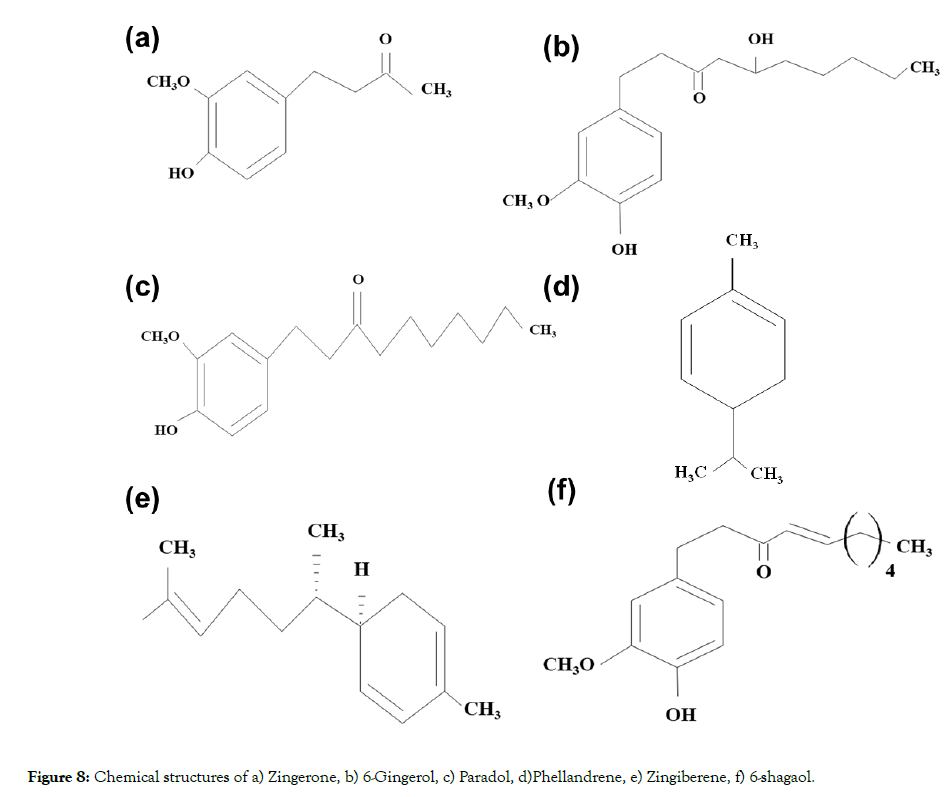
Figure 8: Chemical structures of a) Zingerone, b) 6-Gingerol, c) Paradol, d)Phellandrene, e) Zingiberene, f) 6-shagaol.
In comparison to the dried ginger, the fresh ginger is reported to inhibits human respiratory syncytial virus ( HRSV)-induced plaque formation when taken in proper doses in both A549 (adeno carcinomic human alveolar) and HEp-2 (human laryngeal carcinoma) cell lines. Also, 300 μg/mL of fresh ginger is found to reduce the plaque counts to 19.7% (A549) and 27.0% (HEp-2) compared to the control group, respectively. It shows more promising results when given before viral inoculation (p<0.0001), particularly for A549 cells. Also, intake of 300 μg/mL of fresh gingers before viral inoculation helps in decreasing the plaque formation up to 12.9%. The dependent calculated dose of fresh ginger also inhibits the viral binding (p<0.0001) and its internalization (p<0.0001) process. A fresh ginger in high concentrations helps in stimulating mucosal cells to secrete IFN-β which is expected to contribute in reducing the viral infection. The antiviral effectiveness of fresh ginger against respiratory syncytial virus RSV virus is also reported.
Piper betel (Betel vine, Paan): The betel, also known as Piper betle L., belongs to the family Piperaceae. It is a vedic plant with vedic name as Saptasira. In Sanskrit, it is also known as Nagvelleri, Nagani and Tambool. Its heart shaped leaves are directly used for chewing purposes as they help as aphrodisiac, carminative, tonic, laxative and improve appetite. They possess antiinflammatory, anti-apoptotic, anti-oxidant, anticancer and antimicrobial characteristics and were used as remedy against various diseases. Further, it contains eugenol rich essential oil which is light to dark yellow in color and acts as medicine, stimulant, antiseptic, tonic and is the part of other ayurvedic formulations [86].
It’s under punch amrita present in earth and used from birth to death ceremonies. Leaves extract have hydroxyl chavicol, ally pyrocatechal, Chlorogenic acid, Chavibetol, eugenol, edible natural phenols (present in oil) various antioxidants, vitamins A, B, C, various essential oil which is helpful to boost immune system and give strength to fight against some bacterial and viral infections as shown in Figure 9 [87]. Few compounds are γ- lactone, allyl catechol, p-cymene, caryophyllene, cadinene and eugenol methyl present in varying ratios. Essential oil from leaves is used in respiratory catarrhs. Thus, it affords great relief to cough and easiness from difficulty of breathing. Fruits of betel vine along with honey can also be used as an effective remedy for cough treatment [88].
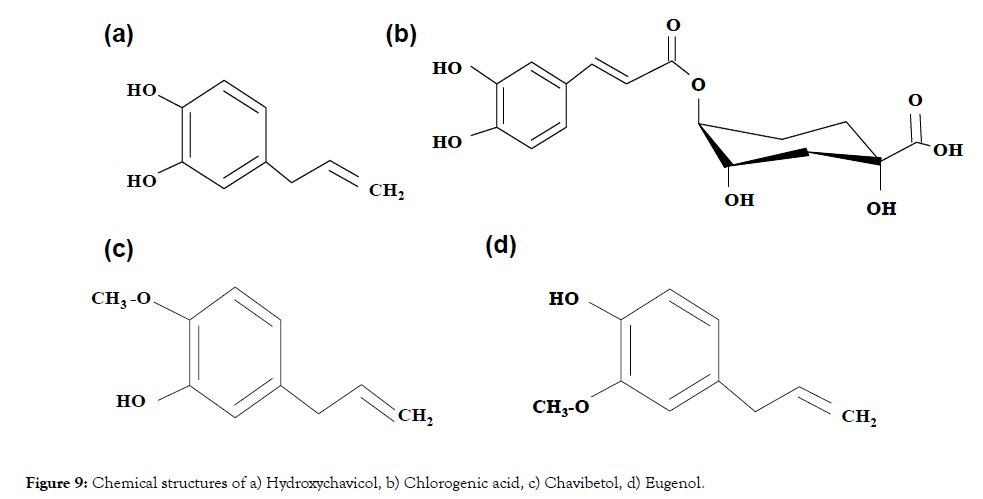
Figure 9: Chemical structures of a) Hydroxychavicol, b) Chlorogenic acid, c) Chavibetol, d) Eugenol.
Also, the antioxidant and anti-inflammatory characteristics of betel leaf extracts are capable of scrimmaging against influenza like disease [89-91]. Further, it is expected that if betel leaf ingredients in coordination with commercially available influenza specific antiviral are tested, may show a synergistic activity. There by supporting in reducing the effective dose of antiviral drug and thus helps in reducing the drug cost, pressure and development of resistant viral strains in the patient [92-95].
The eugenol compound in the oil of P. betel leaf shows its cardiac, hypersensitive and respiratory depressant effects along with antibacterial, antifungal and other therapeutic benefits [96-98]. Hydroxychavicol, a phenolic compound, available in the betel leaves has been identified to have anti-carcinogenic activity [99]. Landraces of betel vine and various volatile constituents available in their extracted essential oil were also investigated. The eugenol was reported to be present in high concentrations in all the investigated species along with 51 different phytochemicals. Similarly, the importance of essential oil and its constituents in Betel leaf has been reported by various other researchers in literature [100]. Slight variation in the chemical composition of the essential oils extracted from different betel vine species has been reported which can be due to the various factors like climate, soil quality and agronomic practices etc. Betel vine leaf extracts possess antioxidant activity along with essential oil.
Curcuma domestica (Turmeric, Haldi): Turmeric, also known as Curcuma domestica is a perennial herb and belongs to the family Zingiberaceae (ginger). The turmeric powder mainly consist of carbohydrates, protein, fat, dietary fiber and minerals, essential oils and curcuminoids. The main phytochemical includes diarylheptanoids such as curcumin, demehoxycurcumin and bisdemethoxycurcumin and the chemical structure of which is depicted in Figure 10 below [101]. The germacrone, turmerone, atlantone and zingiberene are the group of major essential oils which are present in turmeric.
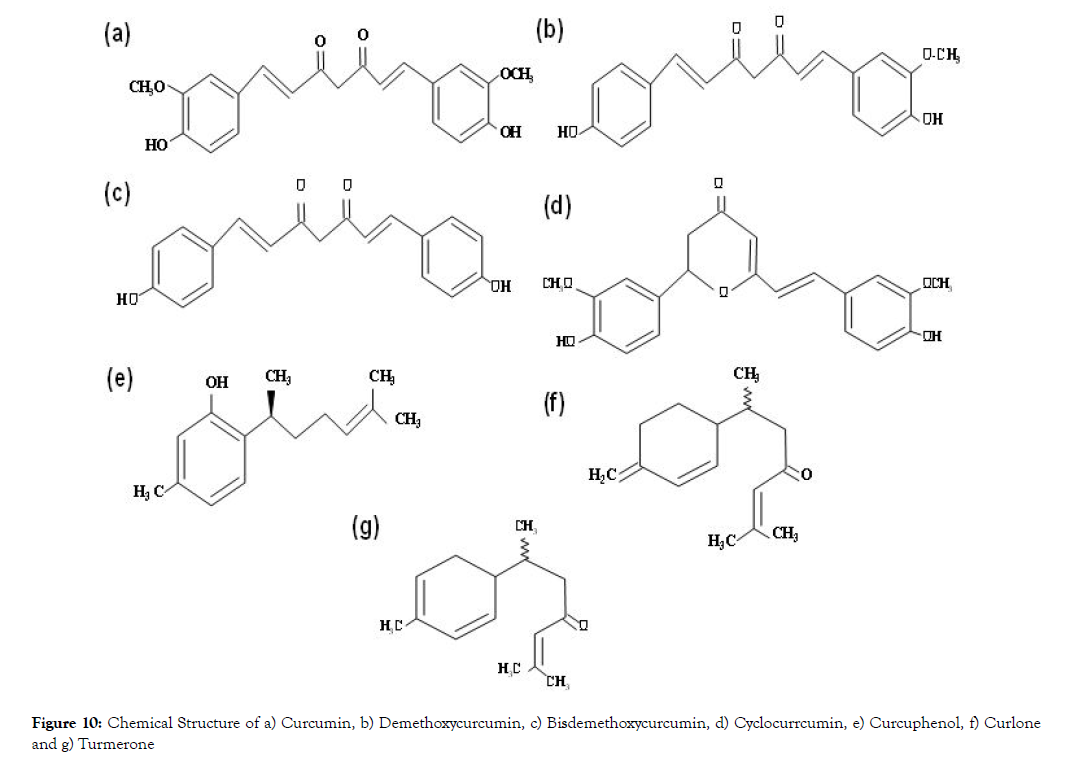
Figure 10: Chemical Structure of a) Curcumin, b) Demethoxycurcumin, c) Bisdemethoxycurcumin, d) Cyclocurrcumin, e) Curcuphenol, f) Curlone and g) Turmerone
Mainly the rhizome, portion of the turmeric plant is used for medicinal purpose, as a flavor in many cuisines and also as a medicine to treat many diseases with potential antiinflammatory properties. It is also employed for curing of various severe diseases like hematuria, hemorrhage, flatulence, jaundice, menstrual difficulties and colic or treatment of many skin diseases in the form of ointment. The larger exports of turmeric for consuming in its raw form especially in corona virus infected countries are confirming its increased interest. Due to its antiviral effect the domestic sales of turmeric have also increases. Turmeric helps in the natural cleansing of the respiratory tract; it also supports in fighting against infection and its anti-inflammatory quality relieves individuals in cases of cold and flu. It is well known fact that the lower immunity is a risk in its own way and Curcumin is very helpful in addressing such issues and enhancing the immunity system. Curcumin inhibits inflammation, relieves congestion and pain thereby supports in improving the breathing process of patients with bronchial problems like sinusitis, sinus during respiration [102].
The main upper respiratory tract problems include congestion, cough, bronchial asthma, cold and shortness of breathing and thus affecting children and elderly population. Due to inflammation of the air ways, the process of breathing becomes difficult. This is often related to an exaggerated response but the immune system that leads to chronic inflammation and damage to lung tissue by free radicals is competently supported by the pharmacological effects of Curcumin. Turmeric is most common rhizome which is used daily in food and some time as a home remedy or drugs against cough and cold, throat infection. It has antiseptic properties with substantial antibacterial, antifungal and antiviral properties. The most effective compounds are curcumin, arturmerone and (-) zingiberene. Curcumin ’ s antiviral properties are due to its inhibitory role towards virus RNA replication which leads to reduction in the viral load. It also has excellent antiinflammatory properties and also reported to strengthen the immunity [103].
Withania somnifera (Ashwagandha, Indian ginseng): Ashwagandha or Rasayana (Tonic), or Withania somniferous, since 6000 BC is one of the very important and precious herbs of Indian Ayurvedic system. Ashwagandha has main chemical constituents of phytochemicals namely withanolides which includes triterpenelactones-withanolides, withaferin A & D, steroidal lactones, alkaloids, tropine and cuscohygrine, respectively. These with anolides are bioactive compounds and due to their cyclo-oxygenase-2 inhibition property they possess anti-inflammatory and analgesic activities with chemical structure as depicted in Figure 11 below [104].
It is seen that the pharmacological activity of Withania somnifera is mostly attributed to withaferin A and withanolide D. According to Ayurveda experts, it is reported that Whithanone reduces the electrostatic component of binding free energies of ACE2-RBD complex and thus block or weakens the COVID-19 entry and its subsequent infectivity. It is also reported that the host cells namely ACE 2 in the human body got entrapped by SARS-CoV-2 with the help of its spike protein Receptor-Binding Domain (RBD) [105]. In order to response it, the natural phytochemicals present in the medicinal herb Withania somnifera has distinct effects on the binding of virus within the human body. In view of the same, the potential capabilities of natural photochemical in Ashwagandha were screened and tested using a unique scientific molecular docking process. It is also reported/ claimed that “Ashwagandha could be the top choice among various medicinal herbs in this prospective fight against COVID-19 infectivity”. Ashwagandha roots have high antiviral activities. Baba Ramdev claimed Ayurveda remedy that world help ward off corona virus. Combinations of photochemical in ashwagandha, gloy, tulsi are capable to fight corona virus as informed by Patanjali ’ s Balkrishna. It inhibits the protein binding with host cell. On the other hand, natural phytochemicals have potentials to combat COVID-19 and its pathogenicity. Basically, it blocks the host protein interactions. Indirectly the triple combination is help to boost the immunity against the COVID-19 infection [106].
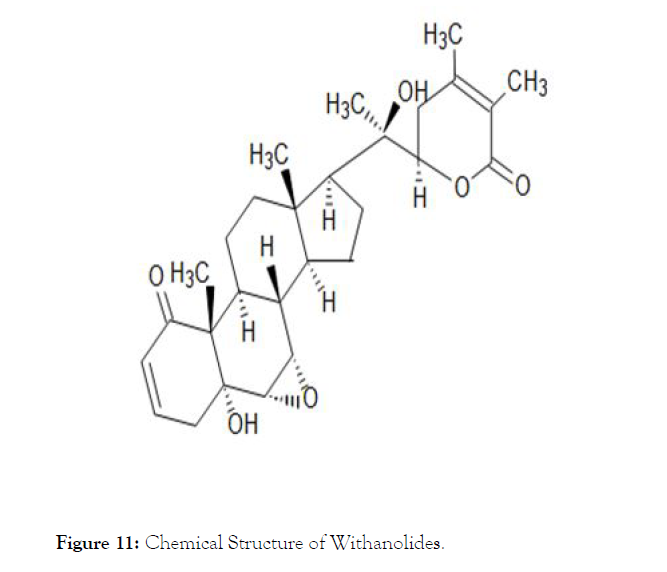
Figure 11: Chemical Structure of Withanolides.
Currently, yet no any vaccine/medicine could be developed to cure COVID-19 and it may take at least 1-2 years and scientist also utilizing hydroxychloroquine to treat COVID-19 but could not get positive response and has side effect. Immune systems in body play an important role to fight against unhealthy environment and microbes such as virus, bacteria, fungus etc. and various numbers of alternate diseases. There are lots of allopathic medicines are available to boost our immune system but we also know that there has number of side effects and are also costly. For this purpose, we find the alternate source as Ayurvedic product and medicinal plant which not only provided healthy environment to body but also boost the immune system without causing any side effect. At this COVID-19 pandemic situation, various studies reveal that those people having strong immunity has higher recovery rate against COVID-19. Since Ayurvedic products cannot completely cure the COVID-19 but it could be minimizing the risk of viral infection and reduces the mortality rate. From long time, we are aware of the beneficial properties of Ayurvedic and medicinal plant product utilizing to cure infectious and other diseases. Since these botanical plants having low cost, minimum toxicity and almost found everywhere in country, it has potential to enhance immunity to fight against COVID-19 and other infectious disease and play an important role to becomes fit and healthy India and world.
We thank Dr. Avanish Kumar Srivastava, Director, CSIRAMPRI Bhopal, India for his interest in this work. This work is supported by funding support from SERB, India (IPA/ 2020/000130) awarded to RK. This work was also supported by CSIR, India (MLP 0205) received by CD.
Citation: Srivastava AK, Chaurasia JP, Khan R, Dhand C, Verma S (2020) Role of Medicinal plants of Traditional Use in Recuperating Devastating COVID-19 Situation. Med Aromat Plants (Los Angeles) 9: 359. doi: 10.35248/2167-0412.20.9.359.
Received: 17-Jul-2020 Accepted: 24-Aug-2020 Published: 31-Aug-2020 , DOI: 10.35248/2167-0412.20.9.359
Copyright: © 2020 Srivastava AK, et al. This is an open-access article distributed under the terms of the Creative Commons Attribution License, which permits unrestricted use, distribution, and reproduction in any medium, provided the original author and source are credited.